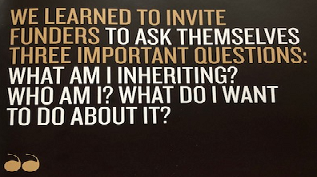My Family Stories: Thickening a Thin Narrative

A real storytelling practice only began in my family about 10 years ago. Like many other families with a strong patriarch, our family foundation needed to make important and difficult decisions together while also managing our differences. In order to be more effective, our multi-family office suggested we “tell the family stories.” Ironically, while my grandmother is a genealogist who has written 17 books about 400 years of my mother’s family line, we had never been much about family storytelling. The data in her books are really just lists of names and dates with little information about people’s values, passions, and personalities. As Dr. Brené Brown says, stories are “data with a soul,” so we set out to add some soul to the genealogy books, and to our understanding of my grandparents.
My mom, sister and I asked Grandma and Grandpa to tell the family stories at our cottage in Michigan that summer. Grandma and Grandpa sat in their favorite chairs facing the lake, and my mom, sister and all sat on the floor looking up at them. We came armed with questions to ease us into storytelling, but I was nervous and didn’t really know what to expect as they are such private people. Despite the trepidation, what I found was a wonderful bonding experience for us all. I had not known just how hands-on and passionate Grandpa was about the causes he gave to and his willingness to roll up his sleeves and act quickly and decisively using all his resources. Subsequently, in our family meetings, I saw my Grandpa in a new light—as someone with passion for good ideas and whose experience working independently and taking action, without others’ input, had served him well in many facets of his life, but created a challenge when we are tasked to decide together using a process.
It wasn’t until I joined 21/64 as Director of Client Engagement and started working with other families that I realized that telling the family stories is only part of the formula for good decision making. We at 21/64 help families make effective decisions, and one of the practices we use to do that is storytelling—starting with three important questions:
What Am I Inheriting? + Who Am I? =
What Do I Want to Do About It?
What Am I Inheriting?
This first question is about the stories of where we come from—the identities of the people upon whose shoulders we stand. In his book Far From the Tree, professor and author Andrew Solomon calls it vertical identity—or directly inherited identity—attributes and values that are passed through the generations. Who are the people who have influenced us and what people, institutions, organizations and cultural factors influenced them? While that made a huge difference in our family foundation work together, it also made me realize that storytelling shouldn’t stop at the patriarch’s stories. As author Chimamanda Adichie says in her TED Talk, there is “the danger of the single story” where if stories are told by only one person or one generation, the meanings often consist of what narrative therapists call “thin descriptions,” which allow little space for the complexities and contradictions of other family member’s stories.
Who Am I?
This second question is about each individual contributing our own story and identity to the family story. I realized our family stories are multistoried—there are many stories occurring at the same time, and the family story is really made up of the many interdependent stories of individual family members. At 21/64, we say that we carry our stories within ourselves, and in order to “thicken” our thin family stories, we must each tell our own stories. Andrew Solomon calls it horizonal identity—independently divergent identity—the attributes and values that are unique to our individual experience and the institutions, organizations, cultural factors and people outside our family that made us who we are.
What Do I Want to Do About It?
Knowing now that my story was not the whole picture is the biggest take-away I have from that day. Second is how important trust and curiosity are to deeper understanding and connection. Thanks to that awkward beginning, I realized how our family stories help us get to know ourselves by understanding those who came before us, as well as help cultivate empathy for our own family. Now I know I want to work with my family members to collaborate together on our family giving, work with other families in my role at 21/64 to help thicken their stories, and embrace the messy complexity that is family while also trying to make the world a better place.
For those of you who want to set out on a storytelling venture this spring or summer, here are resources available for purchase from 21/64 for getting started and “thickening” the plot line. Enjoy!
- Bring Motivational Values Cards to your family spring holiday gathering and ask everyone to share a story behind their strongest value.
- Use our What Am I Inheriting? tool to explore the stories, events and messages you were told growing up, and offer other family members the chance to do the same. Then compare what’s similar and different to thicken a potentially thin story.
- Encourage technology use this summer! Check out the The Grandparent Legacy Project for inspiration, and ask the next gen to bring their devices and find time to ask family elders and story-keepers their stories. Taking photos and recording the conversation for posterity is a gift to everyone
- Ask the young people some questions and grow their horizontal identity. Use our Exploring Next Gen Donor Cards to get started and build connection.
